Cyclone with the Motion of Particles, Ansys Fluent CFD Simulation Training
$120.00 $60.00 Student Discount
In this project, a cyclone with the motion of the particle has been simulated and the results of this simulation have been investigated.
Click on Add To Cart and obtain the Geometry file, Mesh file, and a Comprehensive ANSYS Fluent Training Video.To Order Your Project or benefit from a CFD consultation, contact our experts via email (info@mr-cfd.com), online support tab, or WhatsApp at +44 7443 197273.
There are some Free Products to check our service quality.
If you want the training video in another language instead of English, ask it via info@mr-cfd.com after you buy the product.
Description
Cyclone Project Description
In this project, the motion of particles in a cyclone has been simulated by Ansys Fluent software. We used the one-way DPM to simulate the discrete phase. A cyclone is a device used to separate particles from gas and has many applications in industry.
Geometry & Mesh
The 3D geometry of this project has been produced with SpaceClaim software. The length and width of the computational area is 101 mm, and its height is 363 mm.
Mesh is created with ICEM CFD software and the mesh type is unstructured. The number of cells is 371350.
Cyclone CFD Simulation
To simulate the present model, we consider several assumptions:
- The solver is pressure-based.
- The current simulation is unsteady in terms of time.
- The gravity effect is equivalent to -9.81 m.s-1.
Here is a summary of the steps for defining the problem and its solution in the following table:
| Models | |||
| Viscous model | Reynolds stress | ||
| Discrete phase | on | ||
| particle treatment | unsteady particle tracking | ||
| material in injection | anthracite | ||
| particle type in injection | inert | ||
| injection type | group | ||
| Boundary conditions | |||
| Inlet | Velocity inlet | ||
| velocity magnitude | 5.9 m.s-1 | ||
| discrete phase BC type | escape | ||
| Outlet | Pressure outlet | ||
| gauge pressure | 0 Pascal | ||
| discrete phase BC type | escape | ||
| walls | Wall | ||
| wall motion | stationary wall | ||
| discrete phase BC type | reflect | ||
| Solution Methods | |||
| Pressure-velocity coupling | simple | ||
| Spatial discretization | pressure | second-order | |
| momentum | second-order upwind | ||
| Modified turbulent viscosity | first-order upwind | ||
| Initialization | |||
| Initialization method | hybrid | ||
Cyclone Results
In this simulation, the behavior of particle motion in the cyclone is investigated. It is observed that most of the particles entering from the inlet exit from the lower outlet and air also leaves the upper outlet, and a small number of particles are trapped in the upper part of the cyclone. They are and will continue to rotate forever.
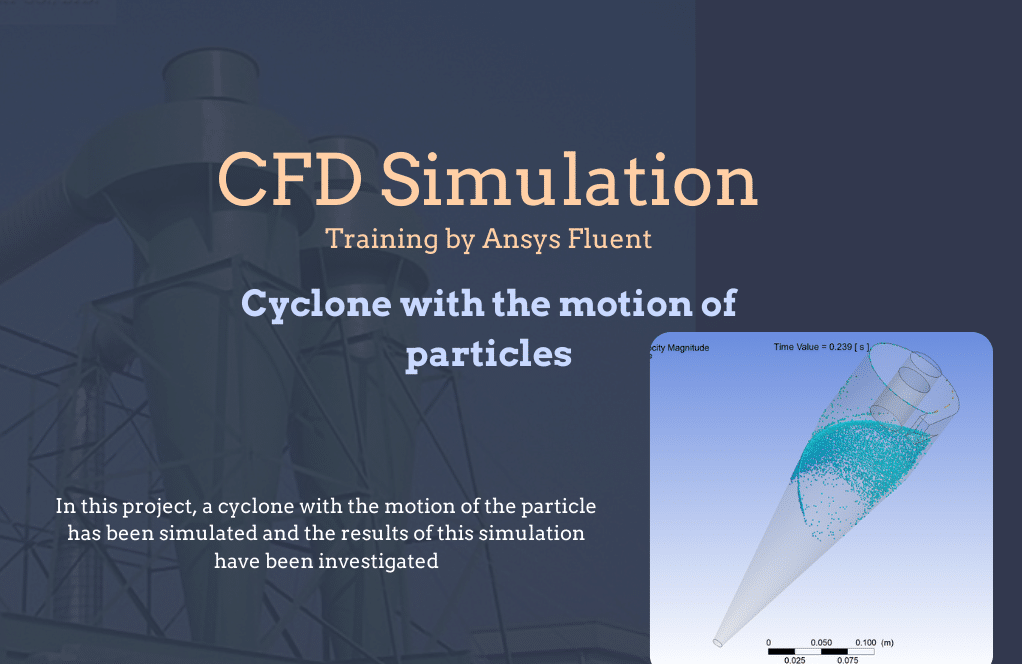
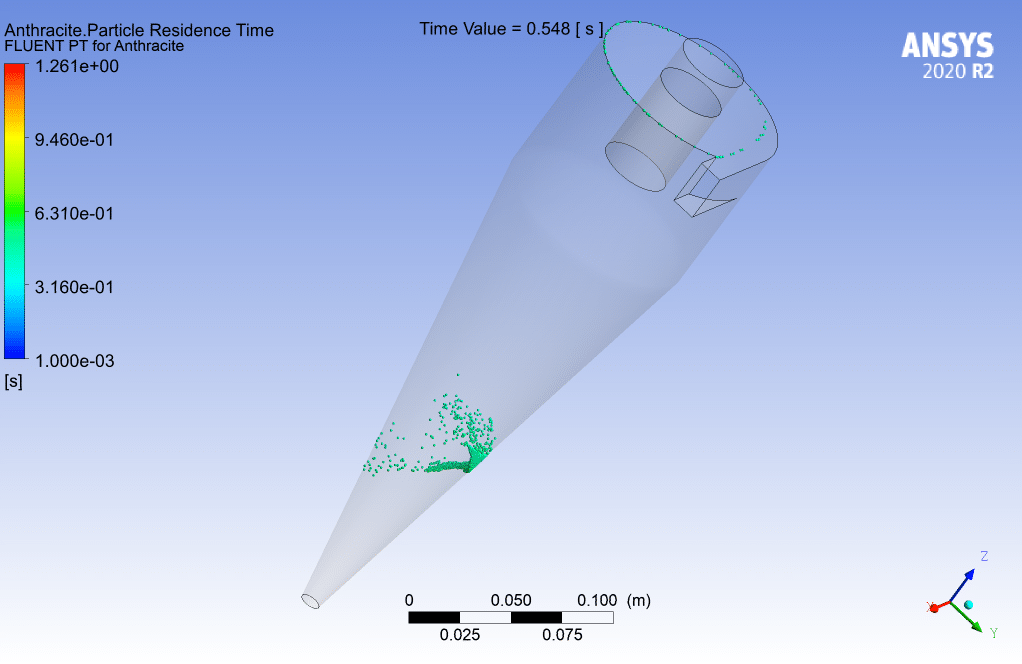
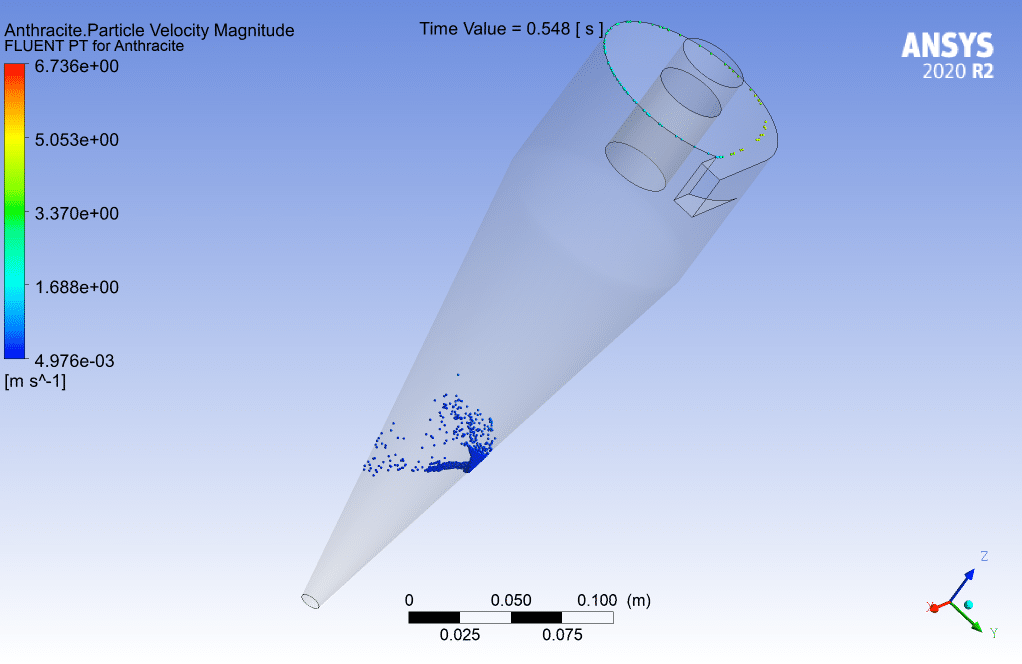
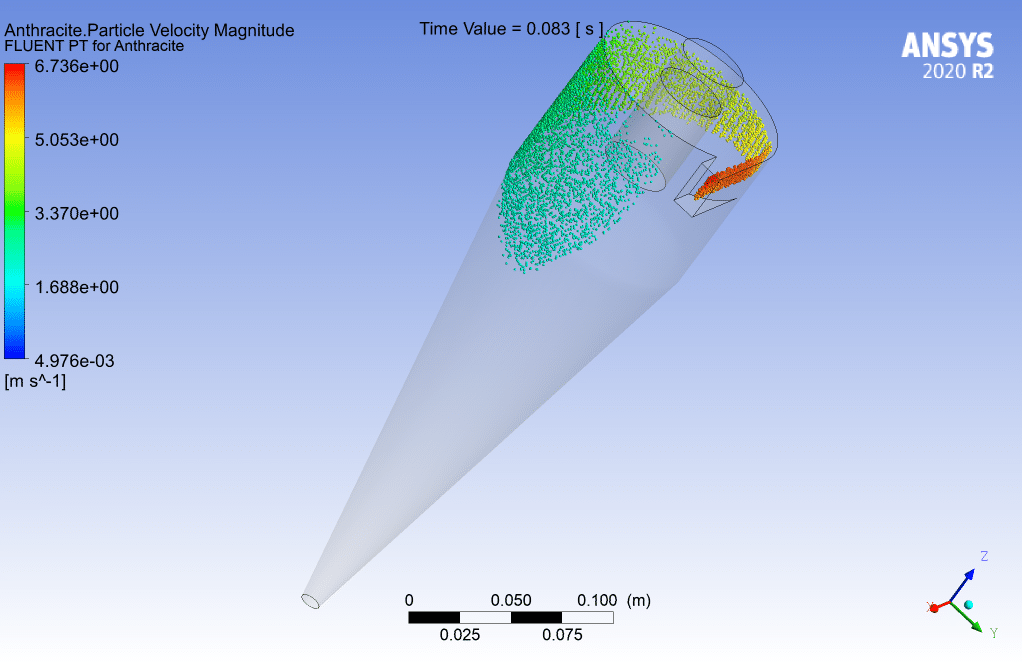
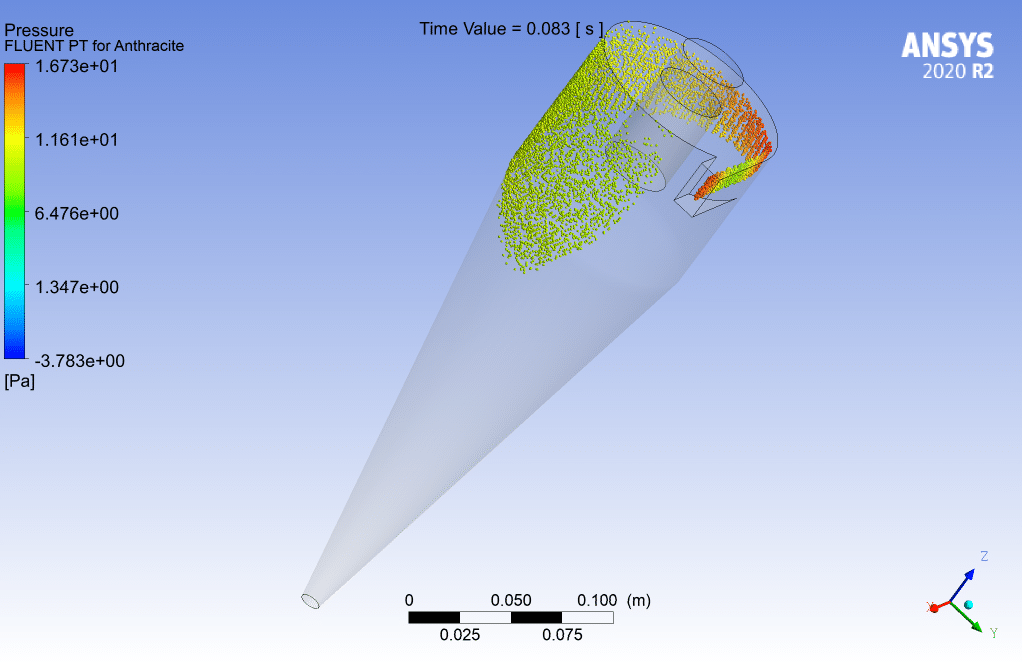
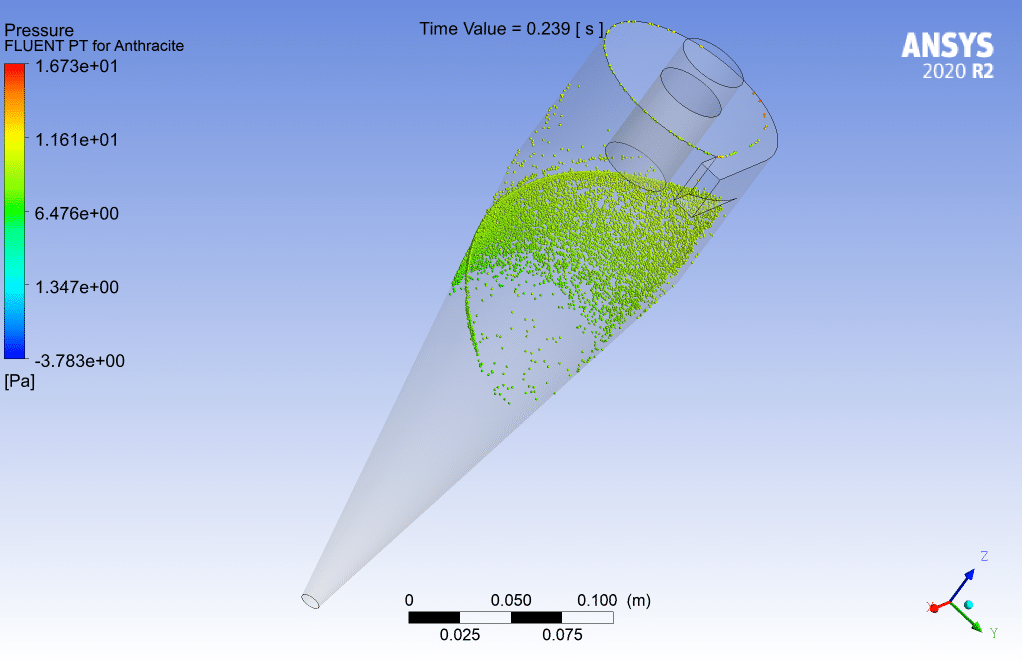




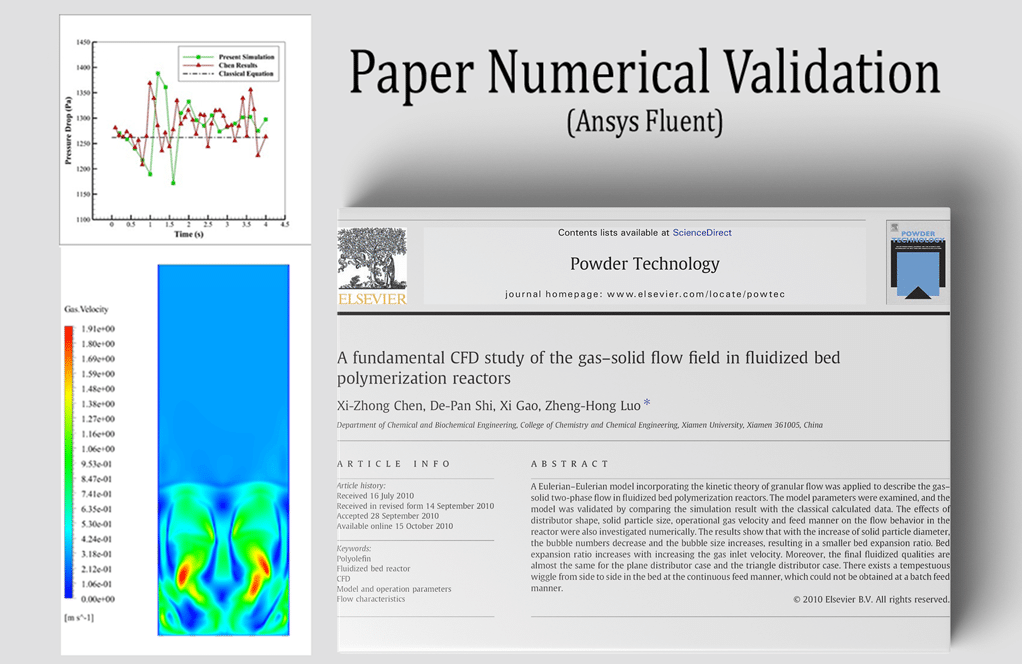

Mr. Stephon Corkery DDS –
I found the detailed process for simulating the motion of particles in a cyclone very interesting. What role does the ‘Reflection’ boundary condition play when particles hit the walls?
MR CFD Support –
The ‘Reflection’ boundary condition in the cyclone simulation is significant. It ensures that when particles in the fluid stream hit the walls of the cyclone, they bounce back into the flow field instead of sticking to the walls or escaping the domain. This mirrors the real-life behavior of particles at impact with the cyclone’s inner surfaces and is crucial for accurately predicting the efficiency and performance of the cyclone separator in removing particles from the gas stream.
Alden Cronin PhD –
The simulation looks in-depth and very detailed, but I’m curious, how does changing the particle type or size in the injection affect the outcome of the CFD simulation? Has this been addressed in the training or tutorial?
MR CFD Support –
Yes, changing the particle type or size can significantly affect the simulation results because the behavior of particles within the cyclone depends on their physical properties like density and diameter. The training provides an insight into how these factors can influence the trajectory and separation efficiency of particles. We cover key points on how to set up and adjust these parameters for different particle characteristics in Ansys Fluent.
Kari Wuckert –
The description mentions ‘particles are trapped in the upper part of the cyclone and will continue to rotate forever.’ Isn’t there a mechanism for these particles to exit or be collected?
MR CFD Support –
In an industrial context, cyclones may be designed with particle collection systems to prevent escape and ensure that particles are removed efficiently. The simulation might have simplified such mechanisms. For more detailed models, the collection process or the fate of trapped particles can be considered.
Terrance Ziemann –
I’m delighted with how the Cyclone project learning material has outlined the simulation steps so precisely. Seeing particle motion within the cyclone is fascinating, and it illustrates the separation process’s efficiency. The clear breakdown of boundary conditions and solver settings is much appreciated.
MR CFD Support –
Thank you for your positive feedback! We’re thrilled that you found the Cyclone project materials detailed and helpful. We strive to provide clarity and precision in our tutorials to enhance understanding. It’s great to hear that the depiction of particle motion met your expectations. If you have any more questions or need further information in your learning journey, feel free to reach out to us. Your success is our priority!
Dr. Otha Feeney –
This training seems fascinating, but I wonder if it’s suitable for absolute beginners? Does it possibly cover fundamental concepts required for understanding detailed simulation processes explained in the project?
MR CFD Support –
Yes, the training course takes both beginners and advanced users into consideration. It introduces essential CFD concepts and principles before delving into the intricacies of running a simulation in ANSYS Fluent, ensuring a comprehensive understanding of both foundational theory and practical application.
Zoie Homenick –
How does the discrete phase model (DPM) account for the influence of particles on the gas flow in this simulation?
MR CFD Support –
In this simulation, we use the one-way Discrete Phase Model (DPM), where the gas flow influences the particles, but the particle-phase does not affect the continuous gas phase. This assumption is often valid when the particle loading is low, so the gas flow field, in this case, remains unaffected by the particles.
Noemie Klein –
What was the escape velocity of the separated particles simulated for this cyclone?
MR CFD Support –
The escape velocity of the separated particles in the cyclone wasn’t explicitly provided in the simulation. The model was mainly focusing on the general behavior of particle motion within the cyclone, using the discrete phase model with given inlet and outlet conditions.
Mrs. Antonetta Hamill –
I was intrigued by how the particles behave differently at the upper and lower outlets. Can you explain why air mostly leaves from the upper outlet and particles from the lower?
MR CFD Support –
Certainly! In a cyclone separator, the design and operation exploit centrifugal force to separate the particles from the gas stream. As the mixture enters the cyclone, it spirals downward in a vortex. Due to the centrifugal force acting on the particles, they have more inertia and are pushed outward against the cyclone’s walls. These particles then fall to the bottom of the cyclone due to gravity and exit through the lower outlet. The air, being less dense than the particles, is subjected to far less centrifugal force and as a result, it can easily change direction and move towards the cyclone’s axial region, escaping through the upper outlet.
Prof. Mateo Olson –
The tutorial was incredibly detailed and provided an excellent understanding of how cyclones work in particle separation. The use of visual elements to illustrate the particle motions made the complex concepts much easier to grasp.
MR CFD Support –
Thank you so much for your kind words. We’re thrilled to hear that our tutorial helped clarify the complexities of cyclone particle separation for you. We strive to provide clear and educational content, and your feedback is greatly appreciated!
Mr. Stuart Heathcote II –
The results finding that some particles are trapped and will rotate indefinitely seems counterintuitive. Can you explain if this is an expected outcome in real-world conditions, or might it point to an area in the simulation steps that could be improved for more accurate results?
MR CFD Support –
In the real-world, it would be atypical for particles to be permanently trapped within a cyclone due to gravity and the downward spiral motion which helps remove separated particles from the cyclone. Having particles indicate perpetual motion could suggest that either simulation time was not sufficient to observe the complete path of the particles or that there might be an aspect in the simulation parameters that needs tweaking, such as the particle drag model or boundary conditions. It’s best to review the simulation setup and potentially consult with further CFD analysis to improve the accuracy of the results.
Kallie Pollich –
The cyclone simulation seems very detailed. Can you explain how the particles are trapped and continue to rotate forever in the cyclone?
MR CFD Support –
In a cyclone separator, the separation of particles from the gas is achieved by centrifugal forces. As the mixed gas and particles enter tangentially, creating a spinning vortex, the larger and heavier particles gain higher momentum compared to the lighter gas molecules. This increased momentum forces the particles to move towards the cyclone’s wall due to centrifugal force, and then drop down because of gravity to the lower outlet. The swirling action within the cyclone and the geometry can, in some cases, cause lighter or smaller particles to be entrained in the upper part of the cyclone. The simulation reflects this as some particles continue to rotate due to the cyclonic action and centrifugality, effectively becoming ‘trapped’ in that pattern unless they collide with others and lose enough energy to fall towards the outlet.
Dr. Charles Beer –
I’ve always been fascinated by cyclones. The simulation seems to capture their complex behaviors. How does the DPM model handle the interaction of particles with the cyclone walls?
MR CFD Support –
In the simulation, one-way Discrete Phase Model (DPM) is used, which tracks the particles through the fluid stream. When these particles encounter walls, the ‘reflect’ boundary condition is applied. This allows the simulation of particle-wall interactions wherein the particles can bounce off the wall, thereby enabling the study of the effects of the cyclone wall on particle trajectories.
Liliane Simonis –
Can you please explain how the discrete phase boundary condition type ‘escape’ affects the outcome of the simulation for both the inlet and outlet boundaries?
MR CFD Support –
The ‘escape’ condition applied to the inlet and outlet boundaries as a discrete phase boundary condition in DPM simulations means that particles that reach these boundaries will exit the computational domain freely. As a result, once particles reach either the inlet or outlet designated with the ‘escape’ condition, they are no longer tracked within the simulation, and their presence from that point on has no impact on the outcomes within the domain.
Dr. Kara Miller DVM –
Absolutely blown away by the detail and clarity offered by the MR CFD training on cyclone particle simulations! The step-by-step approach truly demystified the complexity of setting up and interpreting CFD results for a device as intricate as a cyclone. A special shoutout for covering the one-way DPM aspect so thoroughly. It’s clear that a lot of thought and expertise went into this training package.
MR CFD Support –
Thank you for your positive review! We’re delighted to know our training on cyclone particle simulations met your expectations and rendered the complex concepts more understandable. We take great pride in the expertise that goes into our CFD training packages and are always here should you have further questions or need in-depth insight on DPM or any other simulations. Your success and clarity in understanding is our top priority!
Hassan Flatley –
Is it possible to track the temperature changes of the particles as they pass through the cyclone?
MR CFD Support –
In this specific simulation, the temperature change of the particles is not tracked since the focus was on the motion and separation behavior using the DPM model. Thus, thermal effects were not considered as part of the particulate phase study. If temperature tracking for particles is a requirement, additional models or approaches would need to be implemented within the CFD framework to accurately capture heat transfer dynamics between particles and the fluid flow.
Lila Nicolas –
The detailed flow of how the particles are affected by the cyclone’s geometry and physics was incredibly enlightening. I particularly enjoyed visualizing the air and particle movements through your described results. It’s always fascinating to see the separation process in action!
MR CFD Support –
Thank you for your positive review! We’re glad that the simulation results were able to effectively convey the complex interactions within the cyclone and provided a clear understanding of the particle separation process. Your feedback is highly appreciated!
Halle Padberg –
The included details about the CFD simulation project on cyclone particle movement are impressive! It shows a deep understanding of cyclone operation and the application of different solver mechanisms in ANSYS Fluent. Particularly noteworthy is the use of the unsteady DPM, reflecting the dynamic nature of particle motion within the cyclone. Well done on a comprehensive simulation setup!
MR CFD Support –
Thank you for your kind words and appreciation for the Cyclone with the Motion of Particles CFD Simulation Training. We’re thrilled to hear that you found the details of the simulation project impressive and comprehensive. If you ever have any more questions or need further assistance with similar simulations, do not hesitate to reach out to us!
Mr. Alexys Fisher V –
Wow, this project really helped me understand particle separation in a cyclone. Great job on the detailed representation of the simulation.
MR CFD Support –
Thank you for taking the time to provide your positive feedback! We are very pleased to hear that our CFD simulation training helped enhance your understanding of particle separation in cyclones. If you have any more questions or need further assistance, feel free to reach out!
Oceane Ebert –
I really enjoyed the Cyclone with the Motion of Particles training. The level of detail and practical steps included in the training materials allowed me to truly grasp the complex concepts of discrete phase modeling in a pressure-based unsteady flow simulation. Also, the use of Reynolds stress and inert particle tracking simulations enhanced my understanding of cyclone designs and their industrial applications. Great work on creating such an immersive learning experience.
MR CFD Support –
Thank you for your positive feedback! We’re thrilled to hear that our training on the Cyclone with the Motion of Particles met your educational needs and enhanced your understanding. We continually strive to provide comprehensive and practical CFD learning materials and simulations. If you ever have more questions or need further assistance, don’t hesitate to reach out. Thank you for choosing MR CFD for your learning journey!
Ms. Kaylin D’Amore Sr. –
After the simulation, how can I calculate the exact percentage of particle separation efficiency the cyclone has achieved?
MR CFD Support –
To calculate the particle separation efficiency of the cyclone after the simulation, you will need to analyze the discrete phase model results provided by Ansys Fluent. You can use the particle tracking data and reports to determine the number of particles that have exited through the outlet compared to the number that was injected initially. By using this data, you can calculate the collection efficiency as the number of particles captured over the total particles injected, typically expressed as a percentage.
Prof. Dorcas Lynch Jr. –
The review is excellent. Thank you for providing a clear understanding of how particles are separated in the cyclone simulation.
MR CFD Support –
We’re thrilled that you’re satisfied with the cyclone simulation training! Thank you for your kind words, and we’re here to provide any further assistance or information should you need it.
Prof. Cordie Quigley DDS –
Are the particles considered to interact with the cyclone walls or is there a risk for the particles to adhere to the walls according to this simulation setup?
MR CFD Support –
In the given simulation setup, the discrete phase boundary condition for the walls is set to ‘reflect’. This means that the particles are considered to interact with the cyclone walls by reflecting off them upon contact, rather than adhering to the walls. Therefore, no adhesion of particles to the walls is accounted for in this simulation model.
Johathan Brekke DDS –
The explanation on cyclone simulation is quite thorough, but I’d like to know more about the specific particle properties that were used. What size and density were the anthracite particles, and how does that affect the simulation outcomes?
MR CFD Support –
In the simulation of the cyclone, the anthracite particles were likely characterized by their size and density, which are crucial for the Discrete Phase Model (DPM). These properties directly influence how the particles behave under the influence of various forces within the cyclone, such as drag, gravity, and turbulence. Size determines the drag coefficient and settling velocity, while density impacts the particle inertia. Smaller or lighter particles may follow the gas streamlines more closely, whereas larger or denser particles may be subject to more significant centrifugal forces, making them more likely to be separated from the gas phase. Adjusting these parameters can simulate different operational conditions and predict the cyclone’s efficiency for particle removal.
Prof. Macey Brown I –
What a thorough explanation of the cyclone simulation! I appreciate the detailed summary, including the use of the DPM model and pressure-based solver. I’m especially interested in the boundary conditions chosen for the discrete phase—could you explain why the ‘escape’ condition is used at the inlet and outlet, and ‘reflect’ at the walls?
MR CFD Support –
In the cyclone simulation, the escape boundary condition allows particles that reach the inlet and outlet to exit the domain, which mimics the physical scenario of particles being expelled from the system. The reflect boundary condition on the walls causes particles to bounce off the walls of the cyclone when they collide with them, representing the real-life behavior of particles upon impact with solid boundaries. These boundary conditions help to simulate the complex interactions of particles within the cyclone accurately.